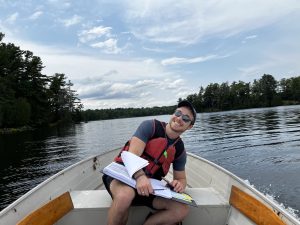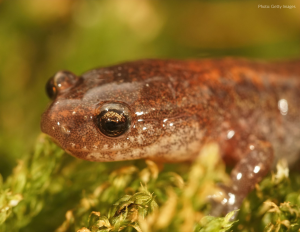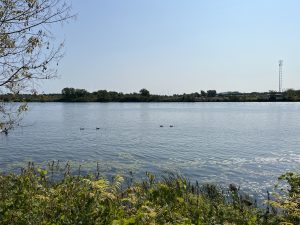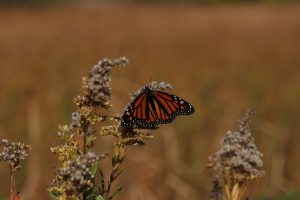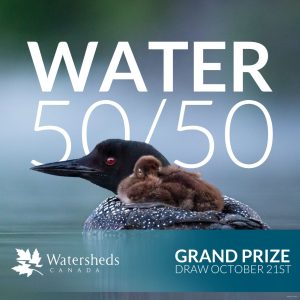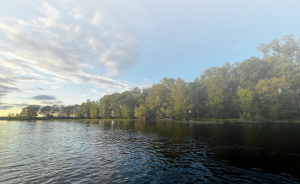by Ty Fischer, Riparian Habitat Restoration Intern Lakes are to Ontarians what the Rocky Mountains are to British Columbians – places of humbling grandeur, of ineffable richness and diversity, and of truly iconic and symbolic importance for our province. It is very fitting, then, that Watersheds Canada and Canadian Wildlife Federation's lake shoreline assessment program be called “Love Your Lake”. I have been fortunate enough to take part in this initiative and to personally witness this ... Read More
Farren Lake residents lead second fish habitat project in twelve months
Westport, ON – Having undertaken two fish habitat restoration projects in a twelve-month period, it is safe to say that the residents of Farren Lake are looking out for their local fish species. In early August 2023, members of the Farren Lake Property Owners Association (FLPOA) gathered for the second time to create and deploy brush bundles on their lake. Now with both the eastern and western portions of the lake rehabilitated with underwater sticks and branches, residents of the lake can ... Read More
The Eastern Red-Backed Salamander and Our Shared Shoreline Responsibility
by Andres Clavier, Freshwater Stewardship Education Intern World Habitat Day, October 2nd, offers a moment to reflect on the interconnectedness of life within our Canadian landscapes. To commemorate, let us delve into the fascinating world of a prolific Canadian salamander species: the Eastern Red-Backed Salamander (Plethodon cinereus). This amphibian can teach us much about the value of shoreline habitats and the crucial role that we can play in conserving these unique ecosystems. From ... Read More
What’s your favourite river?
by Chloe Lajoie, Natural Edge Program Manager Today is a special day - today is World Rivers Day. As the program manager of Watersheds Canada’s program, The Natural Edge, I have helped landowners, students, community partners and volunteers, and municipalities plant over 104,000 native species to bring nature back to severely degraded shorelands. That work is happening right now! However, our fall planting season is tall on restoration site demands and short on funds. You help us get ... Read More
Join the Monarch Butterfly on its epic journey from Canada to Mexico!
by Andres Clavier, Freshwater Stewardship Education Intern Every year in the fall, millions of monarch butterflies embark on a long-distance journey, migrating thousands of kilometres from North America to California and even central Mexico. This incredible phenomenon is an essential event for our environment as these butterflies are important players in pollination and food chain integration for the geographies they cover. Because of this long journey, these beautiful creatures are facing ... Read More
Big news! Water 50/50 is here.
by Nicole Dubé, Freshwater Health Coordinator Do you love to play in the water? If your summer was anything like mine, it was full of cannonballs off the dock, rope swings into the river, and paddle boards across a back bay. There's nothing better than freshwater fun, right? Even as fall approaches, I am excited to share that you can continue to play in the water with our new 50/50 campaign called water5050.ca. Watersheds Canada is making its debut splash into our first-ever charity ... Read More
The Doug Smith story
by Robert Pye, Executive Director Toward Doug Smith’s end of life, he asked Watersheds Canada to tell his story. “As I grew up, I spent a lot of time near water. I loved the water,” said Doug, as his wife, Janet Taylor, sat by his side. Together, they shared fond cottage memories in a heartfelt interview filmed near their Ottawa home on March 1st. Two weeks later, Doug passed away. He was 81. Doug’s poetic message about the value of lakes and rivers, and the need for freshwater ... Read More
“Sustaining Our Freshwater” for today and tomorrow
by Alana Coulombe, Education programs administrator By understanding the importance of Canada’s freshwater supply, we can work together to protect this natural resource for generations to come. Canada holds one-fifth of the world’s total freshwater resources yet only about 7% of this global supply is renewable freshwater (Environment and Climate Change Canada [ECCC], 2013). Additionally, an estimated 60% of Canada’s freshwater supply drains to the north, while about 85% of the population ... Read More
Why is blue-green algae (cyanobacteria) becoming more prominent?
by Alana Coulombe, Education programs administrator The frequency and magnitude of blue-green algal blooms continue to rise across Canada and are expected to be further exacerbated by the impacts of climate change and traditional land use practices. The rise in cyanobacterial blooms brings about health, social, economic, and supply problems in the availability of Canada’s freshwater resources (Codd et al., 2017). What is blue-green algae? Blue-green algae, or cyanobacteria, are ... Read More
Watersheds Canada now accepting intents of interest for Canada-wide climate change resilient shorelands project!
Watersheds Canada is accepting intents of interest from volunteer-led waterfront and nature-focused groups to participate in an exciting new, nationwide project funded by the RBC Foundation through RBC Tech for Nature. This project will run for two years and will focus on getting shoreline renaturalization tools and resources in the hands of groups already leading local environmental change in their community, particularly around shoreline and freshwater health. Canada’s freshwater is under ... Read More
- « Previous Page
- 1
- …
- 8
- 9
- 10
- 11
- 12
- …
- 20
- Next Page »

